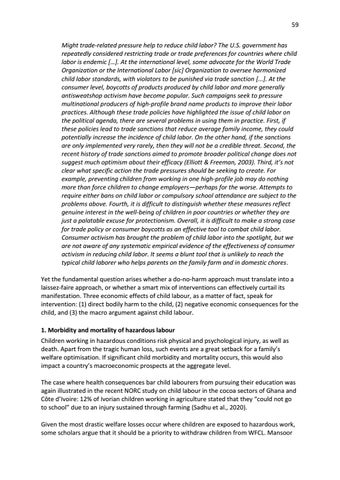59 Might trade-related pressure help to reduce child labor? The U.S. government has repeatedly considered restricting trade or trade preferences for countries where child labor is endemic […]. At the international level, some advocate for the World Trade Organization or the International Labor [sic] Organization to oversee harmonized child labor standards, with violators to be punished via trade sanction [...]. At the consumer level, boycotts of products produced by child labor and more generally antisweatshop activism have become popular. Such campaigns seek to pressure multinational producers of high-profile brand name products to improve their labor practices. Although these trade policies have highlighted the issue of child labor on the political agenda, there are several problems in using them in practice. First, if these policies lead to trade sanctions that reduce average family income, they could potentially increase the incidence of child labor. On the other hand, if the sanctions are only implemented very rarely, then they will not be a credible threat. Second, the recent history of trade sanctions aimed to promote broader political change does not suggest much optimism about their efficacy (Elliott & Freeman, 2003). Third, it’s not clear what specific action the trade pressures should be seeking to create. For example, preventing children from working in one high-profile job may do nothing more than force children to change employers—perhaps for the worse. Attempts to require either bans on child labor or compulsory school attendance are subject to the problems above. Fourth, it is difficult to distinguish whether these measures reflect genuine interest in the well-being of children in poor countries or whether they are just a palatable excuse for protectionism. Overall, it is difficult to make a strong case for trade policy or consumer boycotts as an effective tool to combat child labor. Consumer activism has brought the problem of child labor into the spotlight, but we are not aware of any systematic empirical evidence of the effectiveness of consumer activism in reducing child labor. It seems a blunt tool that is unlikely to reach the typical child laborer who helps parents on the family farm and in domestic chores. Yet the fundamental question arises whether a do-no-harm approach must translate into a laissez-faire approach, or whether a smart mix of interventions can effectively curtail its manifestation. Three economic effects of child labour, as a matter of fact, speak for intervention: (1) direct bodily harm to the child, (2) negative economic consequences for the child, and (3) the macro argument against child labour. 1. Morbidity and mortality of hazardous labour Children working in hazardous conditions risk physical and psychological injury, as well as death. Apart from the tragic human loss, such events are a great setback for a family’s welfare optimisation. If significant child morbidity and mortality occurs, this would also impact a country’s macroeconomic prospects at the aggregate level. The case where health consequences bar child labourers from pursuing their education was again illustrated in the recent NORC study on child labour in the cocoa sectors of Ghana and Côte d’Ivoire: 12% of Ivorian children working in agriculture stated that they “could not go to school” due to an injury sustained through farming (Sadhu et al., 2020). Given the most drastic welfare losses occur where children are exposed to hazardous work, some scholars argue that it should be a priority to withdraw children from WFCL. Mansoor
5 0 Billion Euros: Europe's Child Labour Footprint in 2019

Turn static files into dynamic content formats.
Create a flipbookArticles inside
Issuu converts static files into: digital portfolios, online yearbooks, online catalogs, digital photo albums and more. Sign up and create your flipbook.












